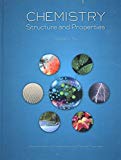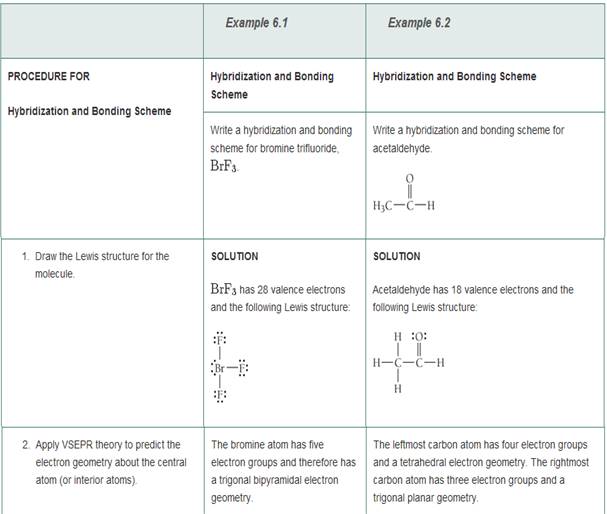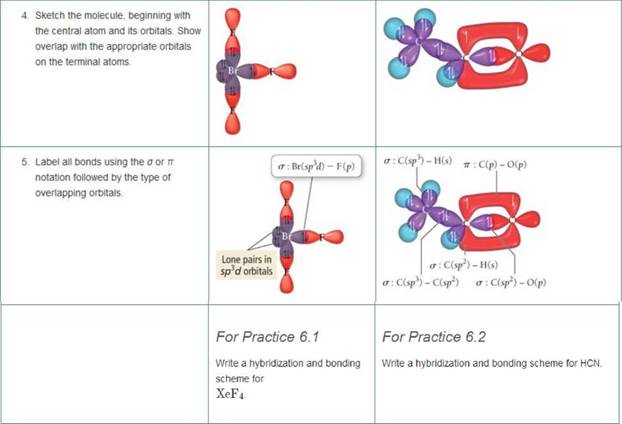
Chemistry: Structure and Properties Custom Edition for Rutgers University General Chemistry
15th Edition
ISBN: 9781269935678
Author: Nivaldo J. Tro
Publisher: Pearson Education
expand_more
expand_more
format_list_bulleted
Concept explainers
Textbook Question
Chapter 7, Problem 44E
Write a hybridization and bonding scheme for each molecule that contains more than one interior atom. Indicate the hybridization about each interior atom. Sketch the structure, including overlapping orbitals, and label all bonds using the notation shown in Examples 6.1 and 6.2.
- C2H2 (skeletal structure HCCH)
- C2H4 (skeletal structure H2CCH2)
- C2H6 (skeletal structure H3CCH3)



Expert Solution & Answer
Want to see the full answer?
Check out a sample textbook solution
Students have asked these similar questions
Predict the product formed when the compound shown below undergoes a reaction with MCPBA in CH2Cl2. MCPBA is meta-chloroperoxybenzoic acid.
k
https://app.aktiv.com
STARTING AMOUNT
6 58°F
Clear
+
F1
X
Dimensional Analysis - Aktiv Chemistry
Your Aktiv Learning trial expires on 02/25/25 at 02:14 PM
Question 19 of 22
Polyethylene terephthalate (PET) is used in plastic water bottles. A water bottle has a
mass of 14.0 grams. Given a density of 1.38 g/cm³, what is the volume of the
plastic used to make the water bottle in cm³ ?
ADD FACTOR
ANSWER
RESET
ว
100
14.0
0.01
10.1
1000
0.099
1.38
0.001
Q Search
F5
-O+
F6
F7
+
F3
F2
W
E
S4
ST
#3
F4
%
5
Y
R
S
&
7
cm³
g/cm³
g
ם
F8
* 00
8
F9
P
ل
DOD
S
F10
F11
F12
Insert
D
F
G
H
J
K
+ 11
A doctor gives a patient 10 Ci of beta radiation. How many betaparticles would the patient receive in 1 minute? (1 Ci = 3.7 x 1010d/s)
Chapter 7 Solutions
Chemistry: Structure and Properties Custom Edition for Rutgers University General Chemistry
Ch. 7 - Determine the hybridization about 0 in CH3OH.Ch. 7 - Determine the hybridization about C in H2CO.Ch. 7 - According to the valance bond theory, which kind...Ch. 7 - Use molecular orbital theory to determine the bond...Ch. 7 - Use molecular orbital theory to predict which...Ch. 7 - Use molecular orbital theory to determine which...Ch. 7 - Which hybridization scheme occurs about nitrogen...Ch. 7 - Prob. 8SAQCh. 7 - Prob. 9SAQCh. 7 - Prob. 10SAQ
Ch. 7 - Which type of orbitals overlap to form the sigma...Ch. 7 - Prob. 12SAQCh. 7 - Prob. 1ECh. 7 - What is a chemical bond according to valence bond...Ch. 7 - In valence bond theory, what determines the...Ch. 7 - In valence bond theory, the interaction energy...Ch. 7 - What is hybridization? Why is hybridization...Ch. 7 - How does hybridization of the atomic orbitals in...Ch. 7 - How is the number of hybrid orbitals related to...Ch. 7 - Sketch each hybrid orbital sp sp2 sp3 sp3d sp3d2Ch. 7 - Prob. 9ECh. 7 - Name the hybridization scheme that corresponds to...Ch. 7 - What is a chemical bond according to molecular...Ch. 7 - Explain the difference between hybrid atomic...Ch. 7 - What is a bonding molecular orbital?Ch. 7 - Prob. 14ECh. 7 - What is the role of wave interference in...Ch. 7 - Prob. 16ECh. 7 - Prob. 17ECh. 7 - Prob. 18ECh. 7 - Prob. 19ECh. 7 - Prob. 20ECh. 7 - Prob. 21ECh. 7 - When applying molecular orbital theory to...Ch. 7 - In molecular orbital theory, what is a nonbonding...Ch. 7 - Write a short paragraph describing chemical...Ch. 7 - Prob. 25ECh. 7 - Prob. 26ECh. 7 - Prob. 27ECh. 7 - Prob. 28ECh. 7 - Prob. 29ECh. 7 - Prob. 30ECh. 7 - The valence electron configurations of several...Ch. 7 - The valence electron configurations of several...Ch. 7 - Draw orbital diagrams (boxes with arrows in them)...Ch. 7 - Draw orbital diagrams (boxes with arrows in them)...Ch. 7 - Prob. 35ECh. 7 - Draw orbital diagrams (boxes with arrows in them)...Ch. 7 - Which hybridization scheme allows the formation of...Ch. 7 - Which hybridization scheme allows the central atom...Ch. 7 - Write a hybridization and bonding scheme for each...Ch. 7 - Write a hybridization and bonding scheme for each...Ch. 7 - Write a hybridization and bonding scheme for each...Ch. 7 - Write a hybridization and bonding scheme for each...Ch. 7 - Write a hybridization and bonding scheme for each...Ch. 7 - Write a hybridization and bonding scheme for each...Ch. 7 - Consider the structure of the amino acid alanine...Ch. 7 - Consider the structure of the amino acid aspartic...Ch. 7 - Sketch the bonding molecular orbital that results...Ch. 7 - Sketch the antibonding molecular orbital that...Ch. 7 - Draw an MO energy diagram and predict the bond...Ch. 7 - Draw an MO energy diagram and predict the bond...Ch. 7 - Sketch the bonding and antibonding molecular...Ch. 7 - Sketch the bonding and antibonding molecular...Ch. 7 - Using the molecular orbital energy ordenng for...Ch. 7 - Using the molecular orbital energy ordering for...Ch. 7 - Apply molecular orbital theory to predict if each...Ch. 7 - Apply molecular orbital theory to predict if each...Ch. 7 - According to MO theory, which molecule or ion has...Ch. 7 - According to MO theory, which molecule or ion has...Ch. 7 - Draw an MO energy diagram for CO. (Use the energy...Ch. 7 - Draw an MO energy diagram for HCI. Predict the...Ch. 7 - Prob. 61ECh. 7 - Prob. 62ECh. 7 - Prob. 63ECh. 7 - Prob. 64ECh. 7 - Prob. 65ECh. 7 - Prob. 66ECh. 7 - For each compound, draw the Lewis structure,...Ch. 7 - For each compound, draw the Lewis structure,...Ch. 7 - Amino acids are biological compounds that link...Ch. 7 - The genetic code is based on four different bases...Ch. 7 - The structure of caffeine, present in coffee and...Ch. 7 - The structure of acetylsalicylic acid (aspirin) is...Ch. 7 - Draw a molecular orbital energy diagram for CIF....Ch. 7 - Draw Lewis structures and MO diagrams for CN+, CN,...Ch. 7 - Bromine can form compounds or ions with any number...Ch. 7 - The compound C3H4 has two double bonds. Describe...Ch. 7 - How many hybrid orbitals do we use to describe...Ch. 7 - Prob. 78ECh. 7 - In VSEPR theory, which uses the Lewis model to...Ch. 7 - The resuts of a molecular orbital calculation for...Ch. 7 - Prob. 81ECh. 7 - cis-2-Butene isomerizes (changes its structure) to...Ch. 7 - The ion CH5 + can form under very special...Ch. 7 - Neither the VSEPR model nor the hybridization...Ch. 7 - Prob. 85ECh. 7 - The most stable forms of the nonmetals in groups...Ch. 7 - Consider the bond energies of three iodine...Ch. 7 - How many atomic orbitals form a set of sp3hybrid...
Knowledge Booster
Learn more about
Need a deep-dive on the concept behind this application? Look no further. Learn more about this topic, chemistry and related others by exploring similar questions and additional content below.Similar questions
- Part C IN H N. Br₂ (2 equiv.) AlBr3 Draw the molecule on the canvas by choosing buttons from the Tools (for bonds and + e (×) H± 12D T EXP. L CONT. דarrow_forward9. OA. Rank the expected boiling points of the compounds shown below from highest to lowest. Place your answer appropriately in the box. Only the answer in the box will be graded. (3) points) OH OH بر بد بدید 2 3arrow_forwardThere is an instrument in Johnson 334 that measures total-reflectance x-ray fluorescence (TXRF) to do elemental analysis (i.e., determine what elements are present in a sample). A researcher is preparing a to measure calcium content in a series of well water samples by TXRF with an internal standard of vanadium (atomic symbol: V). She has prepared a series of standard solutions to ensure a linear instrument response over the expected Ca concentration range of 40-80 ppm. The concentrations of Ca and V (ppm) and the instrument response (peak area, arbitrary units) are shown below. Also included is a sample spectrum. Equation 1 describes the response factor, K, relating the analyte signal (SA) and the standard signal (SIS) to their respective concentrations (CA and CIS). Ca, ppm V, ppm SCa, arb. units SV, arb. units 20.0 10.0 14375.11 14261.02 40.0 10.0 36182.15 17997.10 60.0 10.0 39275.74 12988.01 80.0 10.0 57530.75 14268.54 100.0…arrow_forward
- A mixture of 0.568 M H₂O, 0.438 M Cl₂O, and 0.710 M HClO are enclosed in a vessel at 25 °C. H₂O(g) + C₁₂O(g) = 2 HOCl(g) K = 0.0900 at 25°C с Calculate the equilibrium concentrations of each gas at 25 °C. [H₂O]= [C₁₂O]= [HOCI]= M Σ Marrow_forwardWhat units (if any) does the response factor (K) have? Does the response factor (K) depend upon how the concentration is expressed (e.g. molarity, ppm, ppb, etc.)?arrow_forwardProvide the structure, circle or draw, of the monomeric unit found in the biological polymeric materials given below. HO OH amylose OH OH 행 3 HO cellulose OH OH OH Ho HOarrow_forward
- OA. For the structure shown, rank the bond lengths (labeled a, b and c) from shortest to longest. Place your answer in the box. Only the answer in the box will be graded. (2 points) H -CH3 THe b Нarrow_forwardDon't used hand raitingarrow_forwardQuizzes - Gen Organic & Biological Che... ☆ myd21.lcc.edu + O G screenshot on mac - Google Search savings hulu youtube google disney+ HBO zlib Homework Hel...s | bartleby cell bio book Yuzu Reader: Chemistry G periodic table - Google Search b Home | bartleby 0:33:26 remaining CHEM 120 Chapter 5_Quiz 3 Page 1: 1 > 2 > 3 > 6 ¦ 5 > 4 > 7 ¦ 1 1 10 8 ¦ 9 a ¦ -- Quiz Information silicon-27 A doctor gives a patient 0.01 mC i of beta radiation. How many beta particles would the patient receive in I minute? (1 Ci = 3.7 x 10 10 d/s) Question 5 (1 point) Saved Listen 2.22 x 107 222 x 108 3.7 x 108 2.22 x 108 none of the above Question 6 (1 point) Listen The recommended dosage of 1-131 for a test is 4.2 μCi per kg of body mass. How many millicuries should be given to a 55 kg patient? (1 mCi = 1000 μСi)? 230 mCiarrow_forward
arrow_back_ios
SEE MORE QUESTIONS
arrow_forward_ios
Recommended textbooks for you
 Chemistry: The Molecular ScienceChemistryISBN:9781285199047Author:John W. Moore, Conrad L. StanitskiPublisher:Cengage Learning
Chemistry: The Molecular ScienceChemistryISBN:9781285199047Author:John W. Moore, Conrad L. StanitskiPublisher:Cengage Learning Chemistry: Principles and PracticeChemistryISBN:9780534420123Author:Daniel L. Reger, Scott R. Goode, David W. Ball, Edward MercerPublisher:Cengage Learning
Chemistry: Principles and PracticeChemistryISBN:9780534420123Author:Daniel L. Reger, Scott R. Goode, David W. Ball, Edward MercerPublisher:Cengage Learning Chemistry for Engineering StudentsChemistryISBN:9781285199023Author:Lawrence S. Brown, Tom HolmePublisher:Cengage Learning
Chemistry for Engineering StudentsChemistryISBN:9781285199023Author:Lawrence S. Brown, Tom HolmePublisher:Cengage Learning General Chemistry - Standalone book (MindTap Cour...ChemistryISBN:9781305580343Author:Steven D. Gammon, Ebbing, Darrell Ebbing, Steven D., Darrell; Gammon, Darrell Ebbing; Steven D. Gammon, Darrell D.; Gammon, Ebbing; Steven D. Gammon; DarrellPublisher:Cengage Learning
General Chemistry - Standalone book (MindTap Cour...ChemistryISBN:9781305580343Author:Steven D. Gammon, Ebbing, Darrell Ebbing, Steven D., Darrell; Gammon, Darrell Ebbing; Steven D. Gammon, Darrell D.; Gammon, Ebbing; Steven D. Gammon; DarrellPublisher:Cengage Learning Chemistry: Principles and ReactionsChemistryISBN:9781305079373Author:William L. Masterton, Cecile N. HurleyPublisher:Cengage Learning
Chemistry: Principles and ReactionsChemistryISBN:9781305079373Author:William L. Masterton, Cecile N. HurleyPublisher:Cengage Learning Chemistry for Engineering StudentsChemistryISBN:9781337398909Author:Lawrence S. Brown, Tom HolmePublisher:Cengage Learning
Chemistry for Engineering StudentsChemistryISBN:9781337398909Author:Lawrence S. Brown, Tom HolmePublisher:Cengage Learning

Chemistry: The Molecular Science
Chemistry
ISBN:9781285199047
Author:John W. Moore, Conrad L. Stanitski
Publisher:Cengage Learning

Chemistry: Principles and Practice
Chemistry
ISBN:9780534420123
Author:Daniel L. Reger, Scott R. Goode, David W. Ball, Edward Mercer
Publisher:Cengage Learning

Chemistry for Engineering Students
Chemistry
ISBN:9781285199023
Author:Lawrence S. Brown, Tom Holme
Publisher:Cengage Learning

General Chemistry - Standalone book (MindTap Cour...
Chemistry
ISBN:9781305580343
Author:Steven D. Gammon, Ebbing, Darrell Ebbing, Steven D., Darrell; Gammon, Darrell Ebbing; Steven D. Gammon, Darrell D.; Gammon, Ebbing; Steven D. Gammon; Darrell
Publisher:Cengage Learning

Chemistry: Principles and Reactions
Chemistry
ISBN:9781305079373
Author:William L. Masterton, Cecile N. Hurley
Publisher:Cengage Learning

Chemistry for Engineering Students
Chemistry
ISBN:9781337398909
Author:Lawrence S. Brown, Tom Holme
Publisher:Cengage Learning
Stoichiometry - Chemistry for Massive Creatures: Crash Course Chemistry #6; Author: Crash Course;https://www.youtube.com/watch?v=UL1jmJaUkaQ;License: Standard YouTube License, CC-BY
Bonding (Ionic, Covalent & Metallic) - GCSE Chemistry; Author: Science Shorts;https://www.youtube.com/watch?v=p9MA6Od-zBA;License: Standard YouTube License, CC-BY
General Chemistry 1A. Lecture 12. Two Theories of Bonding.; Author: UCI Open;https://www.youtube.com/watch?v=dLTlL9Z1bh0;License: CC-BY